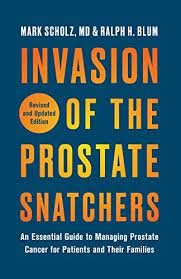
Invasion of the Prostate Snatchers – 2021 Revised Edition Book Review, Howard Wolinsky
Invasion of the Prostate Snatchers: An Essential Guide to Managing ProstateCancer for Patients and Their Families by Mark Scholz, MD & Ralph H. Blum
(Other Press, New York; August 2021)
 Summary: “Invasion of the Prostate Snatchers” is a guidebook for prostate cancer patients and their partners. It is of great interest to patients with low-risk to favorable intermediate-risk cancers considering early disease Active Surveillance (AS) since it critically evaluates types of treatment. AS is close monitoring of lower-risk prostate cancers. A patient with prostate cancer (Blum) and a medical oncologist (Scholz) present information patients can use in making key decisions in their care throughout the prostate cancer disease path.
Summary: “Invasion of the Prostate Snatchers” is a guidebook for prostate cancer patients and their partners. It is of great interest to patients with low-risk to favorable intermediate-risk cancers considering early disease Active Surveillance (AS) since it critically evaluates types of treatment. AS is close monitoring of lower-risk prostate cancers. A patient with prostate cancer (Blum) and a medical oncologist (Scholz) present information patients can use in making key decisions in their care throughout the prostate cancer disease path.
My experience: This book was a just-in-time godsend for me. It was released in August 2010. I was in a holding pattern awaiting a follow-up biopsy at that time.I wasn’t diagnosed until Dec. 4, 2010. My cousin, Maxim Schrogin in Berkeley, California, who was diagnosed in January of that year and was on AS, told me the next day that the first thing I needed to do was get this book. I had it in hand within minutes via Kindle. I devoured “Prostate Snatchers” as I prepared for a second opinion on what, if anything, to do about this cancer.
I went against my first urologist’s advice to go on AS and avoid the side effects of active treatment because AS was not the mainstream approach then. My first urologist tried to rush me into the OR though I only had a single core of less than a millimeter of very low-risk Gleason 6 cancer. That’s the lowest level of prostate cancer,
What I liked about the book: This book helped give me the courage to consider AS and go off the then unbeaten path. It helped prepare me to see Scott Eggener, MD, at the University of Chicago, he told me I didn’t need surgery and was “the poster boy for AS.” A new edition of the book, which came out in August 2021, covers these changes and more. The world has changed since 2010 as reflected in the new edition.” Now,,
multiparametric MRIs have been accepted as the first step when PSAs rise, followed by targeted biopsies. The interval between biopsies is generally longer. Genetic and genomic testing has become more common in the U.S. to help determine whether biopsies are needed and which cancers are likely to become aggressive.
Authors Ralph and Mark plus my wife Judi and cousin Maxim were my “support group” as I became an “active surveillor.” There were no support groups devoted to AS then. I would not meet another patient on AS for seven years. We now have support and educational groups devoted to AS, including those from AnCan and Active Surveillance Patients International.
AS patients are not so rare anymore. We now make up the majority of low-risk patients.
Tips from the book: The book is chock full of background on prostate cancer and actionable information. For example, Scholz weighs in on prostate-specific antigen blood testing: “A PSA is considered a ‘cancer test.’ One savvy patient’s advice is to think of PSA as a nonspecific indicator, like the ‘check engine’ light on your dashboard. An elevated PSA may be due to harmless inflammation, recent sexual activity or even a laboratory error. The first step toward investigating the cause of a high PSA is to repeat the test. If the PSA remains high, the next item to consider is that the prostate may be enlarged (BPH).” The authors point out that if PSA is rising, patients should consider multiparametric MRI and targeted biopsy. Back in 2010, those weren’t quite on the table for discussion.
Nitpicks: No book is perfect. The authors, I think, missed an important discussion on the pros and cons of transperineal vs. transrectal biopsies. Transrectal biopsies can lead to sepsis or other
infections and can miss certain areas in the prostate that may harbor cancers. Also, the authors stressed that patients should seek out MRIs with 3-Tesla magnets. To get into the weeds, some new models with 1.5-Tesla magnets can work just as well and are used routinely at the National Cancer Institute. Discuss these matters with your doctor.

In conclusion: “The Invasion of the Prostate Snatchers” provides a critical look at the prostate cancer “industry” and serves as a bible for newbies considering AS and a reminder to those of us who have been on AS for many years of just why we took the now mainstream approach to low-risk prostate cancer. You can live with these “lame” cancers and not die from them. But you need to maintain
surveillance to detect if your cancer is becoming more aggressive.
Reviewed by Howard Wolinsky, editor of TheActiveSurveillor.com and AnCan moderator
